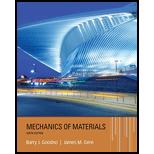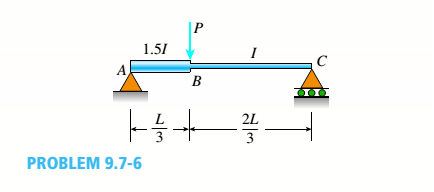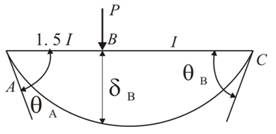
A simple beam ABC has a moment of inertia 1,5 from A to B and A from B to C (see figure). A concentrated load P acts at point B.
Obtain the equations of the deflection curves for both parts of the beam. From the equations, determine the angles of rotation 0Aand Bcat the supports and the deflection 6Bat point B.

The equations of the deflection curve for both parts of the beam, the angle of rotation θA and θC at the supports and the deflection δB at the point for given simple beam.
Answer to Problem 9.7.6P
The equations of the deflection curve for both parts of the beam, the angle of rotation θA and θC at the supports and the deflection δB at the point are as below for given simple beam.
- v=−2Px729EI(19L2−27x2) When 0≤x≤L3
- v=−P1458(−13L3+175PL2x−243Lx2+81x2) When L3≤x≤L
- θA=38PL2729EI
- θC=34PL2729EI
- δB=32PL32187EI
Explanation of Solution
Given Information:
We have the simple beam ABC with moment of inertia 1.5I from point A to B and I from point B to C as per shown figure with a concentrated load P acting at point B:

The length of beam, L
Moment of inertia between A to B, 1.5I
Moment of inertia between B to C, I
Concentrated Load P =B AB=L3and BC=2L3
For the given simple beam, we have deflective curve as shown below:

Now, applying differential equation,
E(IAB)d2vdx2=ME(1.5I)d2vdx2=2Px3 0≤x≤L3EId2vdx2=4Px9 0≤x≤L3.....(1)EId2vdx2=PL3−Px3 L3≤x≤L.....(2)
Now doing integration of equation (1),
EId2vdx2=4Px9 0≤x≤L3EIdvdx=4Px218+C1......(3)
Performing integration for equation (2),
EId2vdx2=PL3−Px3 EIdvdx=PL3x−Px26+C2........(4)
We are applying boundary conditions at x=L3
(dvdxB)left=(dvdxB)right4Px218+C1=PL3x−Px22+C24P18(L3)2+C1=PL3(L3)−P(L3)22+C2C2=C1+4PL2162−PL29+PL218C2=C1−11PL2162......(5)
For equation (3), taking integration,
EIv=4Px354+C1x+C3 0≤x≤L3
For equation (4), taking integration,
EIdvdx=PL3x−Px26+C2EIv=PL6x4−Px318+C2x+C4 L3≤x≤L
In the above equations, applying boundary conditions at
x =0, v=0 and C3=0x =L, v=0
So, we will get,
0=PL36-PL318+C2L+C4 C4=−PL39−C2L........(6)
For boundary conditions at x=L3 ,
(vB)left=(vB)right4P54+C1(L3)=PL6(L3)2−P(L3)318+C2(L3)+C44Px354+C1(L3)=PL354−PL3486+C2(L3)+C4C1L=10PL3243+C2L+3C4.........(7)
With the equation (6) and (7), we will get
C1L=10PL3243+C2L+3C4C1L=10PL3243+C2L−PL33−3C2LC1L=−71PL3243-2C2LC1=−71PL3243-2C2........(8)
From equation (5) and (8), we will get
C1=−71PL3243-2C2+11PL2813C1=−71PL2+33PL22433C1=−38PL2243C1=−38PL2729
So,
C1=−71PL2243-2C2−38PL2729=−71PL2243-2C22C2=−71PL2243+38PL27292C2=−213PL2+PL2729C2=−175PL21458C3=0C4=13PL31458
So,
dvdx=1EI[4Px218+C1]dvdx=1EI[4Px218−38PL2729]dvdx=1EI[324Px2−76PL21458]dvdx=−4P1458EI[−81Px2+19L2]dvdx=−2P729EI[19L2−81Px2] 0≤x≤L3
When,
0≤x≤L3dvdx=1EI[PLx3−Px26+C2]dvdx=1EI[PLx3−Px26−175PL21458]dvdx=1EI[486PLx−243Px2−175PL21458]dvdx=−P1458EI[175L2−486Lx+243x2]
Angle of rotation at point A,
θA=−(dvdx)x=0θA=2P729EI(19L2)θA=38PL2729EI
Angle of rotation at point C,
θC=+(dvdx)x=LθC=P1458EI(175L2−486L2+243L2)θC=68PL21458EIθC=34PL2729EI
Deflection of the beam is as follows:
v=−2Px729EI(19L2−27x2) When 0≤x≤L3When L3≤x≤Lv=1EI(PL6x2−Px318+C2x+C4) v=1EI(PL6x2−Px318+−175PL21458x+13PL31458) v=−P1458(−13L3+175PL2x−243Lx2+81x2) When L3≤x≤L
Deflection at point B,
δB=(v)x=L3δB=2P(L3)729EI[19L2−27L29]δB=2PL3(729EI)[19L2−3L2]δB=2PL3(729EI)[16L2]δB=32PL32187EI
Conclusion:
The answers are calculated by integration and boundary conditions.
Want to see more full solutions like this?
Chapter 9 Solutions
Mechanics of Materials (MindTap Course List)
- An Inclining experiment done on a ship thats 6500 t, a mass of 30t was moved 6.0 m transvesly causing a 30 cm deflection in a 6m pendulum, calculate the transverse meta centre height.arrow_forwarda ship 150 m long and 20.5 m beam floats at a draught of8 m and displaces 19 500 tonne. The TPC is 26.5 and midshipsection area coefficient 0.94. Calculate the block, prismatic andwaterplane area coefficients.arrow_forwardA vessel loads 680 t fuel between forward and aft deep tanks. centre of gravity of forward tank is 24m forward of ships COG. centre to centre between tanks is 42 m. how much in each tank to keep trim the samearrow_forward
- Beam of a vessel is 11% its length. Cw =0.72. When floating in SW of relative denisity 1.03, TPC is 0.35t greater than in freshwater. Find the length of the shiparrow_forwardAn inclining experiment was carried out on a ship of 4000tonne displacement, when masses of 6 tonne were moved transverselythrough 13.5 m. The deflections of a 7.5 m pendulurnwere 81, 78, 85, 83, 79, 82, 84 and 80 mm respectively.Caiculate the metacentric height.arrow_forwardA ship of 10 000 tonne displacement has a waterplanearea of 1300 m2. The ship loads in water of 1.010 t/m3 andmoves into water of 1.026 t/m3. Find the change in meandraughtarrow_forward
- A ship of 7000 tonne displacement has a waterplane areaof 1500 m2. In passing from sea water into river water of1005 kg/m3 there is an increase in draught of 10 cm. Find the Idensity of the sea water.arrow_forwardA ship has 300 tonne of cargo in the hold, 24 m forward ofmidships. The displacement of the vessel is 6000 tonne and its centre of gravity is 1.2 m forward of midships.Find the new position of the centre of gravity if this cargo ismoved to an after hold, 40 m from midshipsarrow_forwardSketch and describe how ships are supported in dry dock. When and where does the greatest amount of stresses occur?arrow_forward
- Sketch and desribe a balanced rudder and how it is suspendedarrow_forwardA ship 140 m long and 18 m beam floats at a draught of9 m. The immersed cross-sectionai areas at equai intervais are 5,60, 116, 145, 152, 153, 153, 151, 142, 85 and 0 m2 respectively.Calculate:(a) displacement(b) block coefficient(c) midship section area coefficient(d) prismatic coefficient.arrow_forwardA steamer has waterplane area 1680m2 recorded in water with relative denisty 1.013. Displacement = 1200 t, calculate difference in draught in salwater reltive denisity 1.025.arrow_forward
 Mechanics of Materials (MindTap Course List)Mechanical EngineeringISBN:9781337093347Author:Barry J. Goodno, James M. GerePublisher:Cengage Learning
Mechanics of Materials (MindTap Course List)Mechanical EngineeringISBN:9781337093347Author:Barry J. Goodno, James M. GerePublisher:Cengage Learning
